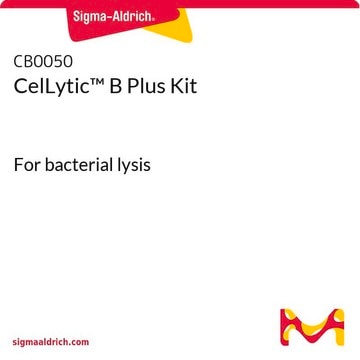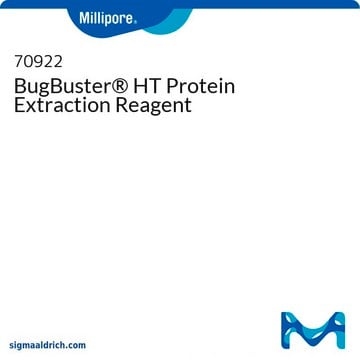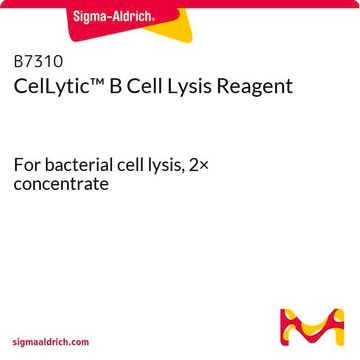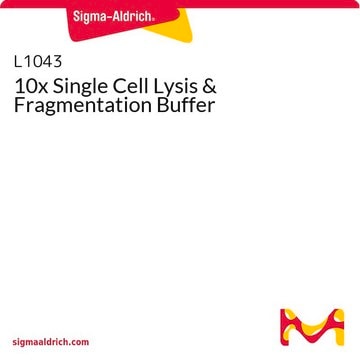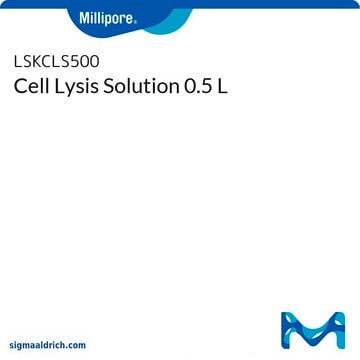This product has not been tested for use in PCR. The formulation for this product is proprietary however, this is a nondenaturing preparation that does contain zwitterionic detergents. Detergents may interfere with PCR at high concentrations.
B7435
CelLytic™ B Cell Lysis Reagent
For bacterial cell lysis, standard strength
Sinonimo/i:
Cell lysis reagent
Scegli un formato
113,00 €
Scegli un formato
About This Item
113,00 €
Prodotti consigliati
Livello qualitativo
Stato
solution
Cerchi prodotti simili? Visita Guida al confronto tra prodotti
Categorie correlate
Applicazioni
Caratteristiche e vantaggi
- Higher protein extraction efficiency than traditional methods such as sonication and lysozyme
- Scalable for 1 to 25 grams of bacterial cell paste
- No interference with downstream applications such as affinity chromatography, IP, and Western blotting
- Compatible with protease inhibitors, inhibitor cocktails, chaotropes, salts, chelating agents and reducing agents
Altre note
Note legali
Prodotti correlati
Avvertenze
Warning
Indicazioni di pericolo
Consigli di prudenza
Classi di pericolo
Eye Irrit. 2 - Skin Irrit. 2
Codice della classe di stoccaggio
12 - Non Combustible Liquids
Classe di pericolosità dell'acqua (WGK)
WGK 3
Punto d’infiammabilità (°F)
Not applicable
Punto d’infiammabilità (°C)
Not applicable
Dispositivi di protezione individuale
Eyeshields, Gloves, type ABEK (EN14387) respirator filter
Scegli una delle versioni più recenti:
Certificati d'analisi (COA)
Non trovi la versione di tuo interesse?
Se hai bisogno di una versione specifica, puoi cercare il certificato tramite il numero di lotto.
Possiedi già questo prodotto?
I documenti relativi ai prodotti acquistati recentemente sono disponibili nell’Archivio dei documenti.
I clienti hanno visto anche
Articoli
ReadyShield® phosphatase and protease inhibitor cocktail FAQ for sample protection in a variety of cell types and tissue extracts, including mammalian, plant, and microbial samples. Our ReadyShield® Protease Inhibitor Cocktail is a non-freezing solution that contains inhibitors with a broad specificity for serine, cysteine, acid proteases and aminopeptidases.
-
Can i use this product for PCR?
1 risposta-
Utile?
-
-
Can I use the CelLytic™ B cell lysate in an activity assay?
1 risposta-
CelLytic B contains a zwitterionic detergent so the protein is active and can be used in protein activity assays.
Utile?
-
-
Can I use CelLytic B for eukaryotic cells?
1 risposta-
CelLytic B was optimized for bacterial cells. It may lyse some mammalian cells. CelLytic B 10X is a better choice for the lysis of yeast and mammalian cells due to the increased detergent concentration.
Utile?
-
-
What is the Department of Transportation shipping information for this product?
1 risposta-
Transportation information can be found in Section 14 of the product's (M)SDS.To access the shipping information for this material, use the link on the product detail page for the product.
Utile?
-
-
What bacterial cells can be used with CelLytic B?
1 risposta-
CelLytic B Reagent by itself (no lysozyme or benzonase) was optimized for E. coli strain BL21. It also works with other common E. coli strains such as DH5?, JM109, and HB 101. The CelLytic B Reagent may be used on other similar bacterial cells. The CelLytic B Plus Kit is compatible with many more difficult to lyse Gram positive bacteria such as Bacillus and Streptococcus.
Utile?
-
-
Can I concentrate my sample that was made using CelLytic B?
1 risposta-
If concentrating a sample, be aware that concentration using filter concentrators may increase the detergent concentration significantly and cause issues in downstream applications. heoretically, ways to get around this are TCA precipitation, or diluting the extract below the CMC prior to concentration. This would be at least a 1/5 dilution, based on the following reference: Saito, S., and Tsuchiya, T., Characteristics of n-octyl beta-D-thioglucopyranoside, a new non-ionic detergent useful for membrane biochemistry. Biochem. J., 222(3), 829-832, 1984.
Utile?
-
-
What is the difference between CelLytic B (Product No. B7435), CelLytic B 2x (Product No. B7310) and CelLytic B 10x (Product No. C8740)?
1 risposta-
CelLytic B 2X has double the strength of CelLytic B for small volume extractions. This allows CelLytic B 2X to be used when a higher protein concentration or lower volume is required. The original formula, CelLytic B, requires 10-20 ml of the reagent for 1 gram of wet cell paste. Only 5 ml of the CelLytic B 2X reagent is required to lyse and extract protein from 1 gram of wet cell paste. CelLytic B 10X is provided as a concentrated mixture of the proprietary detergents found in CelLytic B, without any buffering component. This allows the user to customize the extraction reagent by choosing the detergent concentration and buffering components ideal for the extraction and purification of the protein(s) of interest. CelLytic B 10X is also suitable for the lysis of yeast and mammalian cells.
Utile?
-
-
What is the difference between CelLytic B (Product Nos. B7435, B7310, C8740) and CelLytic B Plus (Product Nos. CB0050 and CB0500)?
1 risposta-
CelLytic B Plus contains CelLytic B, Product No. B7435 as well as lysozyme, benzonase, and a protease inhibitor cocktail for a complete reagent for cell lysates for protein isolation.
Utile?
-
-
Can I obtain protein from inclusion bodies with CelLytic B?
1 risposta-
If the protein is found in inclusion bodies, you need to use an additional reagent, Product No. C5236, CelLytic IB to solubilize the proteins from the inclusion bodies. CelLytic B is used to isolate the inclusion bodies from the bacteria. CelLytic IB, Product No. C5236 can then be used to solubilize the proteins from the inclusion bodies.
Utile?
-
-
When using the CelLytic™ B lysis reagent, do I need to make a dilution prior to measuring protein by Bradford assay?
1 risposta-
When using the CelLytic™ B lysis reagent (B7435, B7310, C8740, and contained in kits CB0050 and CB0500), it is best to use a 1:10 dilution in order to reduce the risk of interference with the Bradford Reagent. A 1:20 dilution would be even better, as long as the protein level remains within the standard curve.
Utile?
-
Filtri attivi
Il team dei nostri ricercatori vanta grande esperienza in tutte le aree della ricerca quali Life Science, scienza dei materiali, sintesi chimica, cromatografia, discipline analitiche, ecc..
Contatta l'Assistenza Tecnica.




